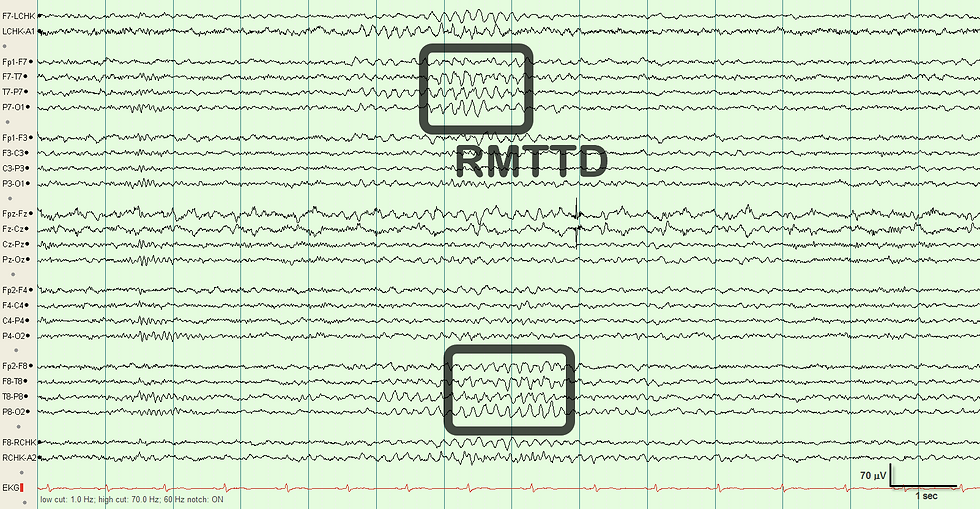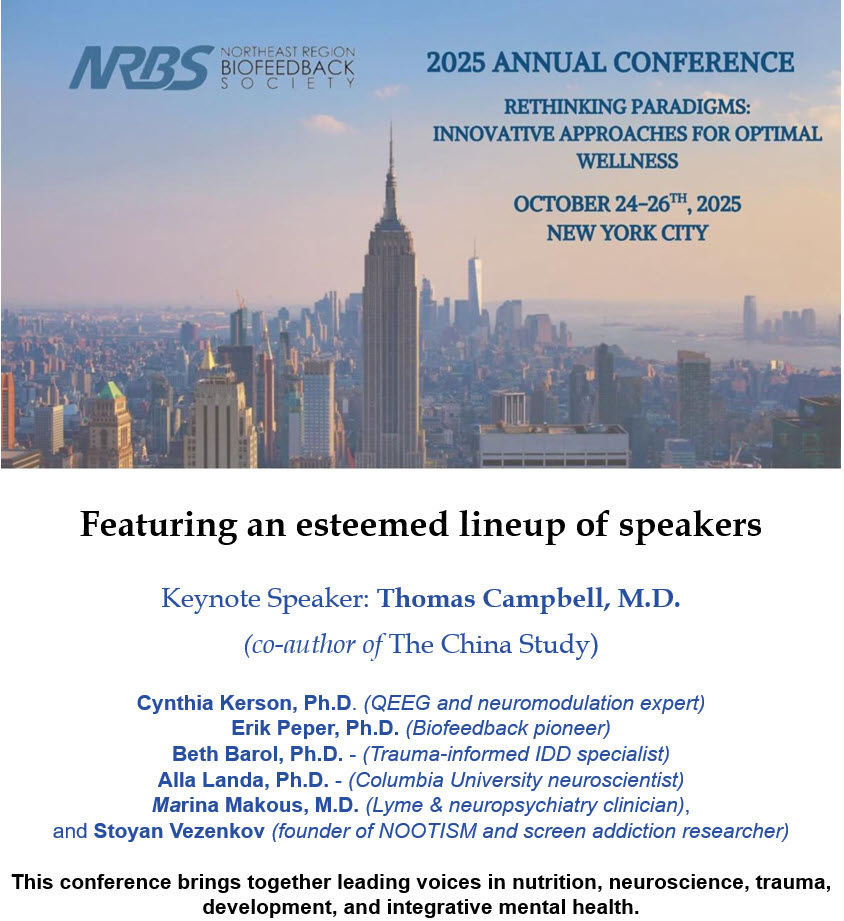Interpreting the Raw EEG: Rhythmic Mid-Temporal Theta of Drowsiness (RMTTD)
- Fred Shaffer
- Jun 19
- 8 min read
Updated: Aug 24

What Is Rhythmic Mid-Temporal Theta of Drowsiness (RMTTD)?
Rhythmic Mid-Temporal Theta of Drowsiness (RMTTD) is a benign, non-epileptiform EEG pattern characterized by rhythmic trains of 5–7 Hz theta activity over the mid-temporal regions, usually maximal at electrodes such as T3 or T4 in the 10–20 system.
RMTTD occurs predominantly in adolescents and young adults but may also be observed in healthy older individuals. RMTTD emerges as part of the normal physiological transition between wakefulness and sleep, especially during Stage I non-REM sleep or relaxed wakefulness with eye closure (Niedermeyer & da Silva, 2005; Yamada & Meng, 2010). While it resembles epileptiform discharges in some respects—particularly due to its sharp contour and rhythmic recurrence—RMTTD is a normal variant with no known pathological significance.
RMTTD is most commonly seen unilaterally but can also appear bilaterally or independently in both hemispheres. Its presence is often intermittent, occurring in brief, self-limited bursts lasting from a few seconds to up to 10 seconds. Despite its sharp appearance, it does not exhibit after-coming slow waves, phase reversal, or field distribution typical of interictal epileptiform discharges.
In recordings of drowsy subjects, RMTTD often coexists with slowing of the posterior dominant rhythm and the emergence of vertex sharp waves, further supporting its link to transitional drowsiness states rather than to epilepsy or cortical dysfunction (Noachtar & Rémi, 2009).
What Is Its Morphology?
RMTTD is composed of rhythmic, sinusoidal theta waves typically in the 5–7 Hz range. The waveforms may appear sharply contoured or notched, but they are organized into rhythmic trains with relatively stable amplitude and frequency. This RMTTD graphic © The Atlas of Adult Electroencephalography.

These bursts are usually seen in mid-temporal derivations, most often unilaterally over T3 or T4, and are not associated with clinical symptoms or behavioral arrest. The individual waveforms within the burst have a somewhat triangular or pointed appearance but lack the abrupt onset, high voltage, or post-discharge slow waves characteristic of epileptiform transients (Schomer & Lopes da Silva, 2011).
The pattern often displays a waxing and waning envelope and may blend with background theta slowing during drowsiness. Some cases show occasional spreading to adjacent electrodes, such as F7 or T5, but the activity remains centered in the mid-temporal region.
Importantly, RMTTD does not disrupt the background rhythm, nor does it evolve in frequency or distribution, which helps distinguish it from ictal patterns or rhythmic slowing due to pathology.
Raw EEG Analysis
The EEG segment above shows a brief, well-formed burst of rhythmic mid-temporal theta activity characteristic of Rhythmic Mid-Temporal Theta of Drowsiness (RMTTD). The activity is most prominent over the right mid-temporal region, involving channels such as T8–P8, T8–F8, and F8–Fp2, with mild posterior spread to P8–O2. The rhythm is composed of sharply contoured waveforms in the 5–6 Hz range. These waveforms are sinusoidal, monomorphic, and organized into a brief rhythmic train lasting several seconds. The pattern displays a waxing and waning envelope and does not evolve in frequency, amplitude, or spatial distribution.
There is no evidence of a field suggestive of epileptiform activity, nor are there after-coming slow waves, voltage asymmetry, or any clinical correlate. The background remains stable, and the rest of the record suggests a drowsy state, as seen by the attenuation of posterior rhythms and the emergence of slower background activity. These features are consistent with RMTTD, which typically arises during drowsiness, especially in adolescents and young adults, though it can also persist into adulthood in neurologically healthy individuals.
The morphology of the theta burst may superficially resemble epileptiform discharges due to its sharp appearance and localization to the temporal lobe. However, the rhythmic structure, lack of evolution, and state-dependent appearance all support a benign interpretation. Unlike interictal epileptiform activity, RMTTD does not show abrupt onset or offset, is not associated with clinical symptoms, and lacks after-going slow waves or post-ictal suppression. It also does not disrupt the ongoing background and is not suggestive of a cortical irritative focus.
This pattern could be misread by inexperienced EEG readers as temporal lobe epilepsy, particularly in the context of a unilateral sharply contoured rhythm in a seizure evaluation. It might also be mistaken for temporal intermittent rhythmic delta activity (TIRDA), but the frequency here is firmly in the theta range, not delta, and the pattern is smoother and more sinusoidal than the polymorphic delta bursts typical of TIRDA.
In this case, the EEG segment reflects a typical example of benign RMTTD—a physiological, drowsiness-related rhythm that should be clearly distinguished from pathological temporal activity to avoid overdiagnosis or unnecessary treatment.
What Causes RMTTD?
RMTTD arises from a normal shift in cortical activity associated with drowsiness. As wakefulness wanes and the brain enters light non-REM sleep, there is increased synchronization in thalamocortical circuits that transiently express low-frequency rhythms, particularly in the theta band (Steriade et al., 1993). The mid-temporal regions, which are anatomically adjacent to limbic structures and highly responsive to state transitions, appear to generate or reflect these rhythms in a form that is spatially restricted and rhythmically organized. This activity likely represents a regionally specific expression of state-dependent thalamocortical synchronization rather than a pathological process.
The predominance of RMTTD in adolescents and young adults may reflect greater sleep pressure, cortical excitability, or developmental variability in drowsiness-related network expression. As the brain matures, the likelihood of exhibiting distinct drowsiness patterns such as RMTTD decreases, although it may persist as a normal variant into adulthood in some individuals (Gregory et al., 2008). RMTTD is also more likely to appear in relaxed, eyes-closed states, particularly when the subject is reclined or recorded in the evening, reinforcing its strong dependence on state modulation.
Importantly, RMTTD is not associated with seizures, epilepsy, or any known clinical symptoms. Multiple studies have confirmed its occurrence in neurologically normal individuals, including those undergoing EEG for unrelated reasons such as syncope or headaches (Yamada & Meng, 2010). Its recognition as a non-pathologic variant is essential for avoiding diagnostic errors and unnecessary treatment.
Which Alternatives Must Be Ruled Out?
The principal risk in interpreting RMTTD is mistaking it for interictal temporal spikes, particularly those associated with temporal lobe epilepsy. This is due to the fact that RMTTD often includes sharply contoured waveforms, is localized to temporal regions, and may occur in brief bursts that mimic the temporal clustering of spikes.
However, a closer inspection reveals key differences. Unlike epileptiform discharges, RMTTD is monomorphic and rhythmic, does not evolve over time, and lacks a subsequent slow wave (Noachtar & Rémi, 2009). The activity tends to appear only during drowsiness and is not associated with any electroclinical correlate.
RMTTD may also be confused with temporal intermittent rhythmic delta activity (TIRDA), a known interictal marker of temporal lobe epilepsy. However, TIRDA is slower (1–4 Hz), less sinusoidal, and typically associated with known clinical seizure history or focal structural lesions. In contrast, RMTTD is a theta rhythm (5–7 Hz), appears in healthy individuals, and resolves with full wakefulness or deeper sleep stages (Schomer & Lopes da Silva, 2011).
Another error lies in overinterpreting unilateral patterns as focal pathology. RMTTD is frequently unilateral but this does not imply lateralized dysfunction. In fact, unilateral occurrence may reflect asymmetrical sleep onset or localized thalamocortical activation and has no predictive value for epileptogenicity. Recognizing these distinctions is essential to prevent misdiagnosis, particularly in contexts such as EEG screening for first-time seizure evaluation or pre-surgical assessment.
How Should a Clinician Report It?
When RMTTD is observed in an EEG, the report should clearly state its features and note that it is a benign drowsiness-related rhythm. A typical description might read: “Rhythmic theta bursts at 5–6 Hz are observed over the left mid-temporal region during drowsiness, lasting up to 6 seconds. The pattern is symmetric in morphology, monomorphic, and without associated slow waves. This finding is consistent with rhythmic mid-temporal theta of drowsiness (RMTTD), a known benign variant.”
The report should avoid ambiguous terminology such as “sharp waves” without clarification, as this can prompt inappropriate further evaluation. If necessary, the report can include a brief educational note for referring clinicians unfamiliar with the pattern, such as: “This variant occurs in healthy individuals and has no known association with epilepsy.”
RMTTD should not be labeled as temporal slowing, epileptiform activity, or interictal abnormality. In contexts where the EEG is performed for seizure screening or neurocognitive symptoms, proper identification of RMTTD prevents over-interpretation and avoids iatrogenic consequences. Its accurate description reinforces confidence in benign findings and helps guide appropriate clinical decision-making.
What We Wish Clinicians Knew About RMTTD?
We wish clinicians recognized RMTTD for what it is: a transient, state-dependent rhythm arising during drowsiness, unrelated to pathology or seizure risk. Its occurrence in mid-temporal regions should not alarm or mislead.
The sharpness of its waveforms can mimic epileptiform features, but these similarities are superficial. RMTTD is defined not by its sharpness, but by its stability, rhythmicity, and relationship to drowsiness.
We wish more clinicians understood that temporal sharp activity is not always epileptiform, especially when embedded in rhythmic trains without aftercoming slow waves. RMTTD reflects normal neurophysiological processes related to vigilance transitions, not dysfunction. It is especially common in adolescents—one of the most overdiagnosed populations in EEG interpretation—where developmental drowsiness patterns are frequently mistaken for pathology (Gregory et al., 2008).
We also wish EEG education emphasized the difference between epileptiform activity and benign sharp variants, such as RMTTD, wicket rhythms, and benign epileptiform transients of sleep (BETS). These patterns can share superficial morphology with true epileptiform discharges, but differ fundamentally in their context, evolution, and lack of associated symptoms.
Above all, we wish EEG readers developed confidence in recognizing normal variants, so that benign patterns like RMTTD are not mistaken for evidence of epilepsy. This requires attention to rhythmic structure, temporal dynamics, and the behavioral state of the patient—not just waveform sharpness or location.
RMTTD is not a threat—it is a sign that the brain is shifting, smoothly, from wakefulness to sleep. Its proper recognition honors the complexity of brain rhythms and prevents the medicalization of normal neural transitions.
Key Takeaways
RMTTD is a benign drowsiness-related pattern, consisting of 5–7 Hz mid-temporal theta bursts without pathological significance.
It often mimics epileptiform activity due to sharp morphology, but lacks after-coming slow waves, evolution, or electroclinical correlation.
RMTTD is most common during relaxed wakefulness or drowsiness, especially in adolescents and young adults.
Proper identification prevents misdiagnosis and overtreatment, especially in epilepsy evaluations.
Its recognition requires careful assessment of context, reactivity, and rhythmic structure, not just waveform sharpness.

Glossary
benign variant: a non-pathological EEG pattern that may resemble abnormal activity but occurs in healthy individuals and lacks clinical significance.
drowsiness: a transitional state between wakefulness and sleep during which EEG rhythms such as RMTTD may emerge.
epileptiform activity: EEG transients such as spikes or sharp waves that differ from background activity and are associated with seizure risk.
focal pathology: a localized area of brain dysfunction or structural abnormality that produces region-specific EEG changes, such as asymmetry, slowing, or epileptiform activity.
monomorphic: a waveform or pattern with a uniform shape and frequency, indicating stability rather than evolution.
RMTTD (Rhythmic Mid-Temporal Theta of Drowsiness): a benign, rhythmic 5–7 Hz theta activity over the mid-temporal region during drowsiness, not associated with epilepsy.
TIRDA (Temporal Intermittent Rhythmic Delta Activity): a 1–4 Hz rhythmic pattern seen in temporal regions, often linked to epilepsy.
theta rhythm: EEG activity in the 4–7 Hz range, seen in drowsiness or as pathological slowing, depending on context.
thalamocortical synchronization: coordinated activity between the thalamus and cortex, underlying rhythmic EEG patterns like alpha and theta.
unilateral pattern: EEG activity seen on one side of the scalp; in RMTTD, this is typical and benign.
vigilance transitions: shifts between levels of alertness, such as from wakefulness to drowsiness or sleep, that are accompanied by characteristic changes in EEG patterns.
References
Gregory, A. M., Eley, T. C., O'Connor, T. G., & Plomin, R. (2008). Etiology of sleep EEG in adolescents: A twin study. Journal of Sleep Research, 17(1), 144–153. https://doi.org/10.1111/j.1365-2869.2008.00640.x
Niedermeyer, E., & da Silva, F. L. (2005). Electroencephalography: Basic principles, clinical applications, and related fields (5th ed.). Lippincott Williams & Wilkins.
Noachtar, S., & Rémi, J. (2009). The role of EEG in epilepsy: A critical review. Epilepsy & Behavior, 15(1), 22–33. https://doi.org/10.1016/j.yebeh.2009.02.035
Schomer, D. L., & Lopes da Silva, F. H. (2011). Niedermeyer's Electroencephalography: Basic Principles, Clinical Applications, and Related Fields (6th ed.). Oxford University Press.
Steriade, M., McCormick, D. A., & Sejnowski, T. J. (1993). Thalamocortical oscillations in the sleeping and aroused brain. Science, 262(5134), 679–685. https://doi.org/10.1126/science.8235588
Yamada, T., & Meng, E. (2010). Practical Guide for Clinical Neurophysiologic Testing: EEG. Lippincott Williams & Wilkins.
About the Author

Fred Shaffer earned his PhD in Psychology from Oklahoma State University. He earned BCIA certifications in Biofeedback and HRV Biofeedback. Fred is an Allen Fellow and Professor of Psychology at Truman State University, where has has taught for 50 years. He is a Biological Psychologist who consults and lectures in heart rate variability biofeedback, Physiological Psychology, and Psychopharmacology. Fred helped to edit Evidence-Based Practice in Biofeedback and Neurofeedback (3rd and 4th eds.) and helped to maintain BCIA's certification programs.
Support Our Friends










Comments